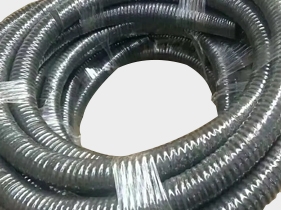
Changchun Sandblasting pipe Structure type of product: sand blasting hose is mainly composed of liquid resistant inner rubber layer, middle rubber layer, 2 or 4 or 6 layers of steel wire winding reinforcement layer and outer rubber layer. The inner rubber layer has the function of bearing the pressure of the transmission medium and protecting the steel wire from erosion, the outer rubber layer protects the steel wire from damage, and the steel wire (0.3-2.0 steel wire) layer is the reinforced skeleton material. Application of sandblasting hose products: high-pressure sandblasting hose is mainly used for mining hydraulic support and oil field exploitation, and is suitable for engineering construction, lifting and transportation, metallurgical forging, mining equipment, ships, injection molding machinery, agricultural machinery, various machine tools, and mechanical and automatic hydraulic systems in various industrial sectors to transport petroleum base with a certain pressure (higher pressure) and temperature. (such as mineral oil, soluble oil, hydraulic oil, fuel oil, lubricating oil) and water-based liquid (such as emulsion, oil-water emulsion, water). And liquid transmission. The working withstand voltage can reach 70-100 MPa. The company's sand blasting hose standards refer to national standards/T10544-03, DIN 20023, and SaE100 R9-13. Sandblasting pipe Where can I find it? Made of special synthetic rubber, it has excellent oil resistance, heat resistance and aging resistance. The rubber hose has high bearing pressure and superior pulse performance. The tube body is tightly combined, soft to use, and has little compression deformation. The hose has excellent bending resistance and fatigue resistance. The sandblasting hose is 20m long and can be made within 50m as required.
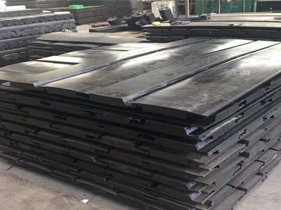
wear-resisting Sandblasting pipe It is a key component of any hydraulic system. When they fail, everything will stop. The preventive maintenance of the metal sandblasting hose is very important and needs to be checked regularly in order to find problems before starting. This may include checking hose caps and fittings, and looking for other signs of leaks and impending hose failure. The more strict the hose inspection process, the more reliable your equipment will be. 1. Benefits of preventive maintenance of metal sandblasting hoses: preventive maintenance of metal sandblasting hoses and equipment is always better than reactive maintenance. One reason is that it can make your equipment run efficiently by solving problems before they fail and have a significant negative impact on the system. Contrary to what many people think, preventive maintenance means reducing downtime due to unexpected component and system failures. Attention to maintenance can also extend the expected life of equipment, maximize its economic value, and minimize potential safety hazards to personnel. Finally, preventive maintenance can reduce maintenance costs and unnecessary equipment procurement. Not participating in regular preventive maintenance can be an expensive decision. 2. Maintenance time of metal sandblasting hose: Sandblasting pipe Where can I find it? Part of the preventive maintenance program for solid metal sandblasting hoses includes periodic inspection of metal sandblasting hoses. Fixed equipment shall be inspected every three months. For mobile equipment, hose inspection shall be conducted every three months or every 400 to 600 hours, whichever comes first.
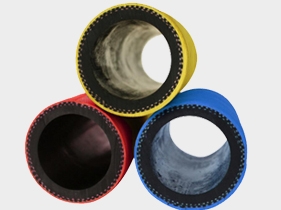
1. The use of protection cannot be ignored: the long-term use of high-pressure sand blasting hose joints at home usually does not cause concern, but excessive use and improper protection also buried the hidden danger of joint cracking to a certain extent. It is understood that the service life of the joint is usually 200000 times, and it should be replaced after long-term use. When using the side, Sandblasting pipe Where can I find it? Care should be taken to close and open as gently as possible and not to rotate the knob of the hose connector repeatedly. 2. Differentiation of quality can be based on standard evidence collection. It is understood that it is still difficult to determine the cause of joint cracking. At present, the National Bureau of Technology and Quality Supervision has issued recommendations for sealing nozzles and hose specifications. These two specifications perfectly adjust the quality specification target of connectors and hoses. Consumers can go to the quality inspection department to check the torsional strength of the connecting hose, the tightness of the connecting spool and the strength of the connecting materials. If the content of standard rules cannot be met, it will be attributed to quality problems, which can serve as a strong basis for expression. 3. The appearance of hose connector is difficult to distinguish between good and bad. In order to pursue profits and reduce costs, many manufacturers currently use selected cast iron (easy to rust) and zinc alloy (non anti-corrosion) as materials to produce high-pressure sand blasting hose joints, which causes product quality problems. It is understood that the quality of connectors and hoses is not up to standard, Changchun Sandblasting pipe The strength function and sealing function of high-pressure sand blasting hose joints are not up to standard due to problems such as materials and wall thickness, which should be paid attention to by consumers.
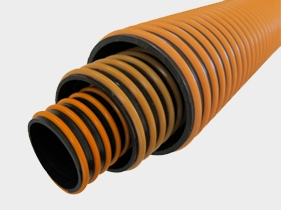
polyurethane wear-resisting Sandblasting pipe Maintenance measures; Cleaning: It is recommended to empty the hose after use. Clean if necessary. Inspection: After each use, the rubber tube must be inspected to ensure that there is no structural damage. Pressure: If the rubber pipe is under great pressure during use, or the outer layer of the rubber pipe will contact with the conveyed liquid for a long time, it is recommended to conduct a hydrostatic test. Due to the natural characteristics of rubber, the physical properties and performance levels of all rubber products will change. This change usually occurs over time, depending on the type of rubber used. However, changes may also accelerate due to several factors or a combination of several factors. Other materials used to reinforce rubber tubing may also be adversely affected by improper storage conditions. Detailed step 1. Polyurethane sand blasting pipe mandrel: the mandrel is usually pulled backward, mainly to increase the firmness of the connection between the mandrel and the hose. After the spindle barb processing is completed, the barb tip must also be passivated, otherwise the barb tip will pierce the lining material of the high-pressure rubber tube during the buckling process. Sandblasting pipe Where can I find it? Even if the high-pressure rubber pipe joint is firmly buckled, if the inner layer is damaged, high-pressure water will leak from the buckle. 2. Polyurethane sand blasting pipe sheath: the sheath is generally in the form shown in the figure, the wall thickness should be moderate, and the internal rectangular tooth height should not exceed 2mm, that is, (d-d) should not exceed 4mm.
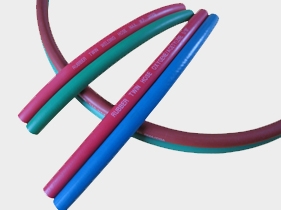
We all know Sandblasting pipe Where can I find it? The noise pollution in industrial production is very serious, and noise pollution is also an important factor affecting workers' enthusiasm for production. Ball mills were once a major source of noise in mining equipment. In order to reduce the noise generated by ball mills, protect the physical and mental health of workers, improve workers' enthusiasm for production, and create greater profits for the company, Through the efforts and research of domestic and foreign industry experts, the ball mill liner has been transformed. Through repeated tests and comparison, it is found that the noise generated by the rubber liner and the manganese steel liner of the ball mill is far less than the manganese steel liner when the technical parameters are up to standard. According to the data provided by the noise monitoring station and the concentrator, We analyzed the noise intensity and the economic benefits: the domestic ND2 precision sound level meter and octave filter were used for detection, and the sound level meter was calibrated by the provincial sound level meter measurement and verification station; There is no sound insulation room in the ball mill workshop. The monitoring points are arranged according to the position of the ball mill and the flow of workers to observe the mechanical operation, 2m away from the sound source. One monitoring point is respectively set on the left and right of the east and west of the workshop and in the middle of the two ball mills. The measurement method is in accordance with the Noise Detection Specification for Industrial Enterprises. As the noise in the workshop is continuous and steady, sound level A is used as the evaluation basis. The rubber lining plate is manufactured by Hainan Rubber Lining Plate Factory according to the ball mill shell structure and the original manganese steel lining plate specification (1.4mx0.74mX0.07m). Changchun Sandblasting pipe First, take out the manganese steel lining plate in the ball mill barrel, and then install the rubber lining plate in the barrel in turn (front and back). Each ball mill is installed with 48 pieces. First, use the pressure strip to compress, and then use the screws to fix the rubber lining plate on the ball mill barrel, so as to prevent falling off when rotating. The noise intensity of the ball mill workshop with manganese steel liner is 94-103dB (A), while the noise intensity of the ball mill workshop with rubber liner is 87-92dB (A), and the noise reduction difference is 7-11dB (A). The rubber liner has good noise reduction effect.







